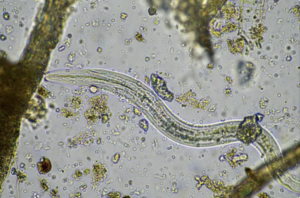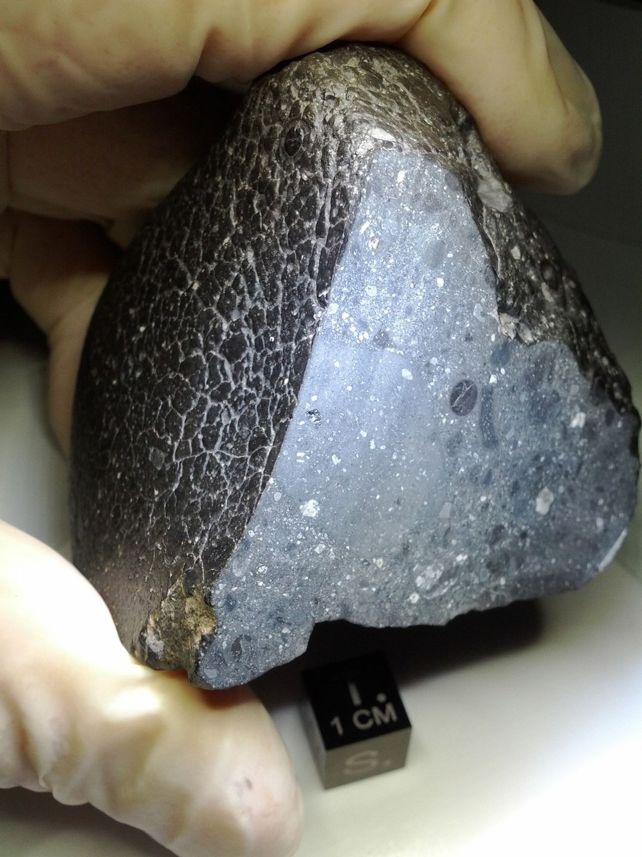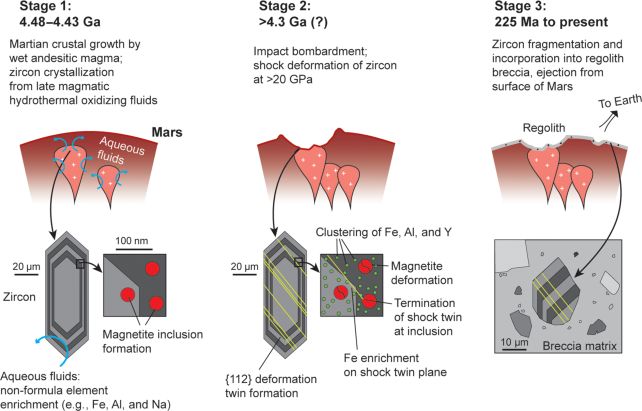What we have is super hot with a working water component. for both Earth and Mars.
For some reason Venus lacks water while the rock is super hot. We need to bombard mars with comets to deliver ample water. This should induce heat radiation and establish a cap of rotting rock holding water.
If Venus is hollow. it may also be internally dry as well. Or simply the water is unable to break out to the surface. After all alternative sources tell us it is good there. just saying, but if all our planets are incubation eggs, then all becomes plausible.
Swedenborg may well have been correctly informed.
The Oldest Evidence For Water on Mars Reveals It Was Extremely Hot
There was water on Mars as early as 4.45 billion years ago, just a short time after the planet formed from the leftover dust of the growing Sun.
The evidence? A tiny grain of zircon, smaller than the width of a human hair, with minerals trapped inside that could only have formed in the presence of water. The sting in the tail? That water had to have been hot, like hot springs, or hydrothermal vents under the ocean.
The discovery tells us several things. First, that the delivery of water to Mars during the early days of the Solar System was similar to that of Earth. Second, the presence of hot water could be consistent with the kinds of extremophile microbial life we see in geothermal and hydrothermal environments.
"The emerging picture is that early Mars and Earth had something in common – both were wet. It is known from analysis of the oldest zircons on Earth that liquid water existed by at least 4.3 billion years ago. We now have evidence for water on Mars that is even older," geologist Aaron Cavosie of Curtin University in Australia told ScienceAlert.
"The evidence for early water on Mars is consistent with the abundant evidence for water on Mars during the Noachian period, which lasted from 4.1 to 3.7 billion years ago. There is good geologic evidence for vestiges of life on Earth at this time, so why not Mars if the conditions were similar? These two planets have clearly taken different paths since then."
Micrograph image of the zircon. (Gillespie et al., Sci. Adv., 2024)
The water history of Mars is difficult to piece together because, well, it's all the way over at Mars, where our exploration efforts are pretty great, but limited. Every now and then, though, a piece of Mars comes to us. One of these is the famous Martian meteorite NWA 7034, or 'Black Beauty', discovered in the Sahara Desert in 2011.
NWA 7034 is a 320-gram (11.3-ounce) piece of volcanic breccia, a chunk of rock that's made up of other chunks of rock, a bit like Christmas pudding. Some of the pieces that make up the meteorite are tiny crystals of zircon – an absolute goldmine for geologists wanting to study the history of Mars, and the history of the meteorite itself.
Not long ago, scientists at Curtin University studied NWA 7034 zircon and found evidence that the chunk of rock had been smacked by a huge asteroid impact 4.45 billion years ago.
Now, researchers led by geochemist Jack Gillespie, of Curtin University at the time of the study, have taken a closer look at some of the minerals trapped inside zircon. Using nanoscale microscopy, they discovered traces of iron, yttrium, aluminum, and sodium that were caught up inside the zircon as it formed.
It took looking around a bit closer to home to figure out what the deposition process for these minerals
must have been.
The Black Beauty meteorite. (NASA)
"Elements like iron, aluminum, and sodium form a series of nice layers in the Martian zircon, similar to those found in an onion. These elements are not normally found in zircon; after finding them in the Martian zircon, we turned our attention back to Earth to find what environments that form in," Cavosie explained.
"One of the few places on Earth where zircons are found with nice layers of these elements is from Olympic Dam, a giant copper, uranium, and gold deposit in South Australia. The connection is that the Olympic Dam zircons are known to have formed in a magmatic-hydrothermal system. That means hot aqueous fluids were present and interacting with the granite when the zircons were forming. These fluids delivered the unusual trace elements, and at Olympic Dam, also concentrated the economic metals."
We don't know the water temperature on Mars. It could have been anywhere from a few hundred to even more than 500 °C (932 °F), similar to the waters of Yellowstone. Nor do we know how much water there was.
But the discovery does show that there was water on Mars not long after the planets formed some 4.5 billion years ago, circulating in the planet's crust, and heated by the volcanic activity that was much more rampant when the planet was young. And this means that Mars may have been actually pretty soggy, with water delivered the same way water arrived at Earth – via comets and asteroids, and incorporated into the planet as it was forming.
"We can't say for sure if liquid water was present on the surface at this time, but we think it's possible. Some of these magmatic fluids would likely have escaped to the surface and contributed water to the atmosphere," Cavosie said.
"This means a lot of warm and wet places within, and probably on, the crust of Mars. Data like those found in our study help to better flesh out the concept of early habitable conditions based on direct analysis of materials formed at that time."
A diagram of the life history of the zircon crystal in the Black Beauty meteorite. (Gillespie et al., Sci. Adv., 2024)
Now that the researchers have discovered evidence that hot water once existed on Mars, they can work to flesh out their findings further. We don't know whether the magmatic activity that heated the water was generated by activity inside Mars, or from the asteroid bombardment that pummeled the early Solar System, for example. We also don't know whether hydrothermal systems were prevalent on Mars.
It would be pretty incredible if there was just one ancient Martian hydrothermal system, evidence of which just happened to end up in human hands billions of years later. But NWA 7034 is already pretty incredible.
"The zircon … has a bonkers crazy survival story! It formed in a wet hydrothermal shortly after Mars came together as a planet 4.45 billion years ago, it got smacked during an early meteorite impact event and later got violently ejected to land in a pile of rock rubble, where it got buried and altered with fluids billions of years later, and then finally got smacked again by another meteorite, this time getting ejected from Mars!" Cavosie told ScienceAlert.
"Instead of heading out into the endless nether-world of space to be lost forever, it ended up crashing into Earth, where it survived being melted away to dust in our atmosphere, just to land in the Sahara desert. Somehow it didn't get buried and lost forever under a sand dune, and instead was found by someone who recognized it as an important stone.
"This rock has only been in the hands of scientists for about 10 years, and look how much it's taught us about Mars."
















